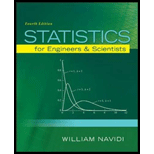Solutions for Statistics for Engineers and Scientists
Browse All Chapters of This Textbook
Book Details
Statistics for Engineers and Scientists stands out for its crystal clear presentation of applied statistics. Suitable for a one or two semester course, the book takes a practical approach to methods of statistical modeling and data analysis that are most often used in scientific work. Statistics for Engineers and Scientists features a unique approach highlighted by an engaging writing style that explains difficult concepts clearly, along with the use of contemporary real world data sets to help motivate students and show direct connections to industry and research. While focusing on practical applications of statistics, the text makes extensive use of examples to motivate fundamental concepts and to develop intuition. McGraw-Hill is also proud to offer ConnectPlus powered by Maple with the fourth edition of Navidi's, Statistics for Engineers and Scientists. This innovative and powerful new system helps your students learn more easily and gives you the ability to customize your homework problems and assign them simply and easily to your students. Problems are graded automatically, and the results are recorded immediately. Natural Math Notation allows for answer entry in many different forms, and the system allows for easy customization and authoring of exercises by the instructor. Navidi's Statistics for Engineers and Scientists, fourth edition, includes the power of McGraw-Hill's LearnSmart - a proven adaptive learning program that helps students learn faster, study more efficiently, and retain more knowledge for greater success. LearnSmart is included in ConnectPlus powered by Maple.
Sample Solutions for this Textbook
We offer sample solutions for Statistics for Engineers and Scientists homework problems. See examples below:
More Editions of This Book
Corresponding editions of this textbook are also available below:
